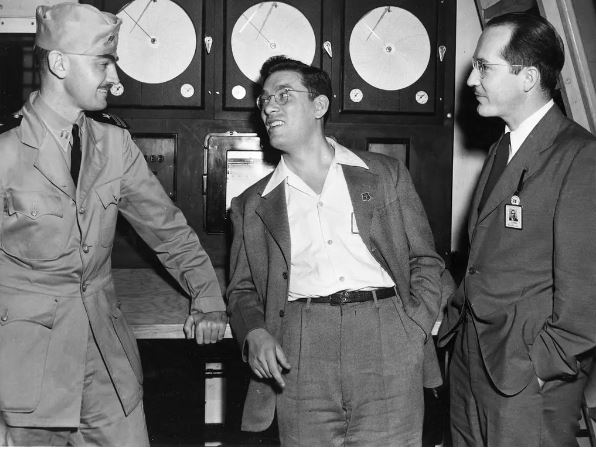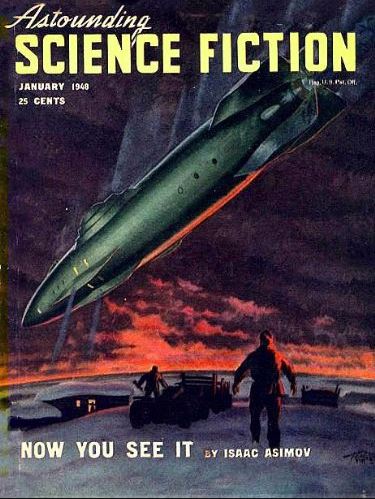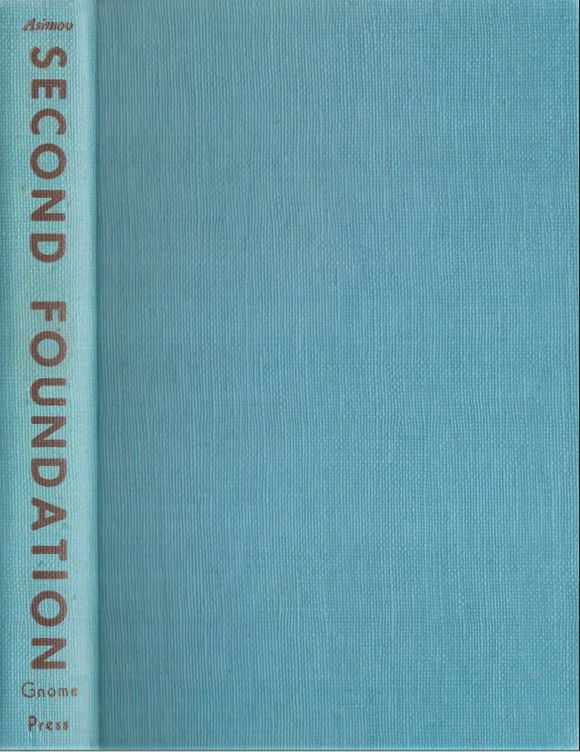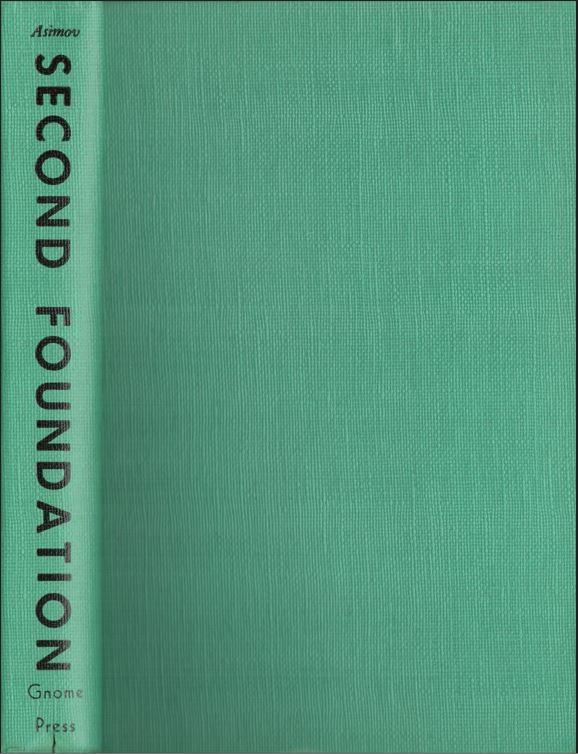Comments
The Foundation series purported to cover the thousand years between the fall of the First Galactic Empire and the rise of the Second. The events in the stories that comprise Second Foundation end only about 300 years into the saga. Normally, an author of a series beloved by fans would continue milking it to completion (and in many cases, beyond). Why Asimov didn’t continue writing Foundation stories isn’t clear. After all, he wrote several robot stories and two robot novels in the 1950s, finding ways to extend the series beyond the seeming denouement contained in “The Evitable Conflict,” the last story in I, Robot. The 12,000-year history of the Galactic Empire would seem to give endless opportunities for one-off takes or whole new sagas. In fact, he had already written one. “Blind Alley” appeared in the May 1945 Astounding, between the two long stories collected in Foundation and Empire. It’s set much earlier than the Foundation stories and so seems never to have been included in any Foundation compilation. Asimov could have ground out as many of these problem-solving stories as he wished.
Admittedly, he had a full-time job teaching at Boston University, but he didn’t give that up until four years after Second appeared. Doing so produced the opposite of a flood of science fiction. Struck by Sputnik and the lack of science knowledge in the public, he wrote non-fiction in epic quantities. Though he often stated that he stopped writing f&sf after 1957, that wasn’t quite true. A smattering of short stories appeared. Doubleday, the publisher who had a lock on his science fiction and was minting money off it, nonetheless kept badgering him for a new Foundation novel. In 1981 they offered him a $50,000 advance for one, a staggering figure for the time. Asimov acquiesced. Over the next decade, two prequels – Prelude to Foundation and Forward the Foundation – and two sequels – Foundation’s Edge and Foundation and Earth, the latter of which ties the Foundation stories in with the robot stories – emerged to great sales and fan acclaim. What followed was less milking than an oil gusher. As a part of this return to science fiction Asimov completed his intended robot detective trilogy with The Robots of Dawn and outlined the origins of the Galactic Empire in Robots and Empire. More would surely have followed if not for his death in 1992. Publishers feasted on the corpse with over two-dozen tie-in novels by other authors. Asimov will be synonymous with robots for a long time to come.
The paperback publication history of Second is beyond odd into a new category of weird. In 1955, Ace published both Foundation as The 1,000 Year Plan and Foundation and Empire as The Man Who Upset the Universe; they were reprinted under the revised titles in the 1960s. Second Foundation didn’t appear under any title in 1958, when Avon published it as 2nd Foundation: Galactic Empire. But not either of the first two. No complete paperback set of the Foundation trilogy books could be bought until Avon issued them in order and under their original titles in 1964 and 1965, apparently a response to the Science Fiction Book Club issuing the trilogy in one hardback volume in 1963. Little more is needed to reveal how totally inconsequential science fiction was to the publishing world in the 1950s and what barriers readers faced to simply having affordable copies of books available to them.
Gnome Notes
How many books are in Gnome’s Foundation Trilogy? Yes, this is a trick question. The answer, based on the number of variants a collector must have, is nine: three Foundations, three Foundation and Empires, and three Second Foundations. These numbers are a 2024 revision, a new variant of Foundation having been found. (Does my variant back panel on the green boards of Empire mark an additional unrecorded variant? I don’t know.)
The original 1953 first edition of Second has two states, blue boards and green boards. The book appeared again in 1955 in gray cloth. This is the CURREY (C) binding, although CHALKER notes that Greenberg himself called it a reprint, which would make it a second printing. ESHBACH confirms that Second had a second printing, mentioning in passing that the Foundation books were Gnome’s best sellers outside Greenberg’s own anthologies.
But doesn’t CURREY list nine total variants? Indeed, listed there is a (D) binding: “Boards with cloth shelf back; DOUBLEDAY/SCIENCE/FICTION at base of spine.” CHALKER lists it as a 1963 Doubleday reprint, using the original plates. Original plates perforce contain the original copyright page. That’s right: this reprint from another publisher states that it is a Gnome Press first edition. What makes this triply bizarre is that Doubleday, in the form of its Science-Fiction Book Club, had earlier put out a true reprint, which properly eliminated all mention of Gnome and of first editions.
There should be no question that CURREY (D) is a Doubleday product. By the end Greenberg was forced to resort to the cheapest paper and boards. The Doubleday edition, in striking contrast, has not yet browned badly and sports a nice cloth cover with a blue cloth backing, very similar to the grace touches Greenberg had used on his early anthologies. Not that form matters. Asimov himself tells us that “In August 1961 an agreement was reached and the Foundation books became Doubleday property.” Gnome could not have issued the edition even if it weren’t moribund in 1963, which it was.
I’m ignoring the Doubleday edition. Therefore, the full Gnome Foundation consists of nine variants, among them three true second printings and a possible third.
As with Empire, Gnome bannered the rear flap with DON’T MISS THE FIRST BOOK! Unfortunately, the next line reads FOUNDATION AND EMPIRE, the second book. Whoever wrote the copy knew that Foundation was the first in the series – it explicitly says so. Why keep the banner then? Another baffling Gnome mystery.
Kirkus Reviews gave the expected publication date as June 25, 1953.
Reviews
Charles Aukerman [a copy boy “who especially enjoys science fiction”], Elyria [OH]Chronicle Telegram, August 25, 1956
The suspense builds as one man after another seems to have the answer in his grasp, only to be proven wrong by later events.
Sam Merwin, Jr., Fantastic Universe, October-November 1953
In fact, it is a question whether “Second Foundation” contains any characters at all. … You’ll derive considerable intellectual if virtually no emotional diversion out of it.
Henry Bolt, Imagination, June 1954
“[W]hat’s the story about?” I’ll answer, “Princesses and kingdoms, empires and galaxies and fairy godmothers. Even Mules! In short – nonsense!” Read it if you must, but don’t say you weren’t warned – it’s not a good book!
Contents and original publication
• “Prolog” (original to this volume).
• part i (rewritten from Astounding Science Fiction, January 1948, as “Now You See It…”).
• part ii (Astounding Science Fiction, November, December 1949, January 1950, as “…and Now You Don’t”).
• “Encyclopedia Galactica” entries (part i: rewritten from “Essays on History,” Ligurn Vier in “Now You See It…”; part ii: original to this volume).
Bibliographic Information
Second Foundation, by Isaac Asimov, 1953, title #33, back panel #23, copyright registration 15May53, Library of Congress Catalog Card Number not given [retroactively 53-10530], 210 pages, $2.75. 5000 copies printed, 1951; 2500 copies printed, 1955?. Hardback. Jacket design by Ric Binkley. “FIRST EDITION” on copyright page. Manufactured in the U.S.A. by H. Wolff. Back panel: 25 titles. Gnome Press address given as 80 East 11th Street, N. Y. 3.
Variants, in order of priority
1) (CURREY A) Blue boards, spine lettered in brown.
2) (CURREY B) Green boards, spine lettered in black.
3) (CURREY C) Gray cloth, spine lettered in red. 1955 printing. [not seen]
Images







